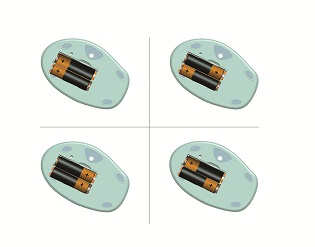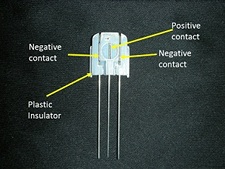Microsoft tech allows sticking batteries in any way you want
Jul 1, 2010 — by LinuxDevices Staff — from the LinuxDevices Archive — viewsMicrosoft announced a hardware solution that will allow users of portable devices — digital cameras, flashlights, remote controls, toys, you name it — to insert their batteries in any direction. Compatible with AA and AAA cells, among others, the patented “InstaLoad” technology does not require special electronics or circuitry, the company claims.
Microsoft's "InstaLoad" technology, which the company says it has patented and will license to device manufacturers, seems poised to end an everyday source of frustration. Inserting batteries with the proper polarity ought to be simple, but is often made difficult by adverse field conditions, bad lighting, unclear diagrams, impatience, or plain old presbyopia.
As Microsoft notes, users get frustrated when devices fail to work because their batteries are backwards. Worse, some products may be damaged permanently by being fed with improper power polarity.
The InstaLoad technology will work with any barrel-type batteries, such as the popular CR123, AA, AAA, C, and D-sizes, regardless of whether they are disposable or rechargeable, says Microsoft. As such, it's applicable to a multitude of products, such as digital cameras, flashlights, remote controls, toys — or battery chargers themselves.

InstaLoad will let you put batteries in that mouse any way you want, Microsoft says
According to Microsoft, InstaLoad requires no electronic circuitry that could add cost to a device or drain battery power. Rather, it involves fitting devices with battery compartments that have positive and negative contacts at both ends, instead of a single positive contact at one end and a negative contact at the other.
Microsoft says a central contact at either end of the battery compartment will support positive connections, while wider outer contacts support negative connections (see below). Once this physical design is combined with appropriate PCB traces, proper power polarity is automatically delivered to a device, the company claims.


Microsoft's InstaLoad
(Click either image to enlarge)
It's said InstaLoad contacts will be especially helpful when they are used in devices that:
- use multiple batteries
- require frequent battery swap out
- may be damaged by having the battery inserted incorrectly
- require battery replacement at inconvenient times or locations
While InstaLoad seems to be a simple concept, Microsoft has apparently spent a significant amount of time in refining its operation — or at least in obtaining a patent. The company says it will not be involved in manufacturing products, but instead will license the technology to third parties on a royalty bas is. The trademark and logo pictured at right will also be licensed, so consumers can be aware when a product incorporates InstaLoad, Microsoft adds.
is. The trademark and logo pictured at right will also be licensed, so consumers can be aware when a product incorporates InstaLoad, Microsoft adds.
Microsoft says a variety of companies are already working to integrate InstaLoad technology in their products, though not all can be named due to technology agreements. Those whose involvement was made public today include AbleNet, AE Light, Black Diamond, ClearSounds, Duracell, Memory Protection Devices, Muyshondt, NovaTac, Serene Innovations, Serfas, and Spectrum Brands.
Further information
In addition to offering licenses, Microsoft says, it's providing device suppliers with a no-charge InstaLoad evaluation kit, which includes a demo unit and detailed design specifications. However, the company's announcement did not say how soon InstaLoad-equipped products will reach consumers.
More information on InstaLoad may be found on the Microsoft website, here.
This article was originally published on LinuxDevices.com and has been donated to the open source community by QuinStreet Inc. Please visit LinuxToday.com for up-to-date news and articles about Linux and open source.